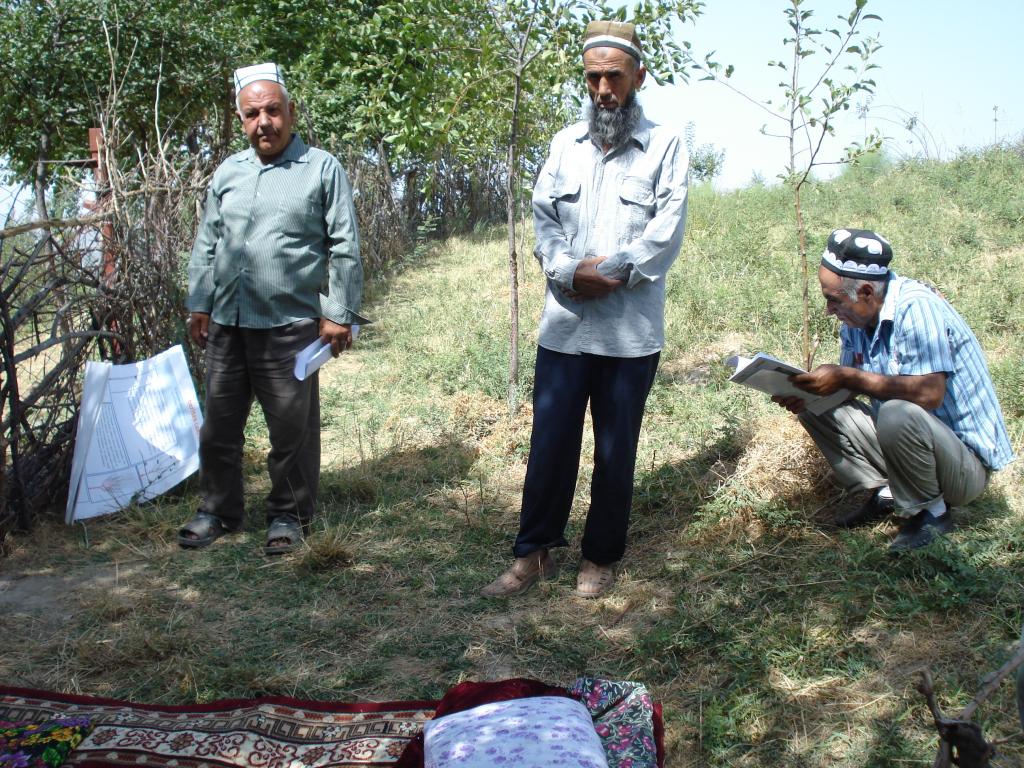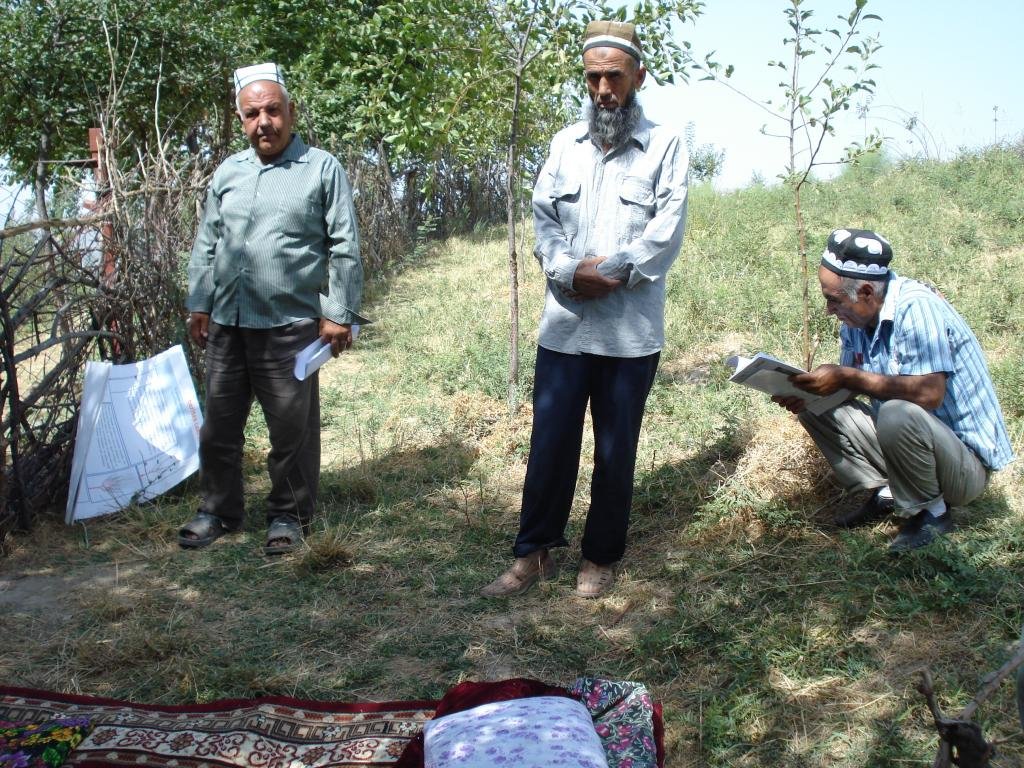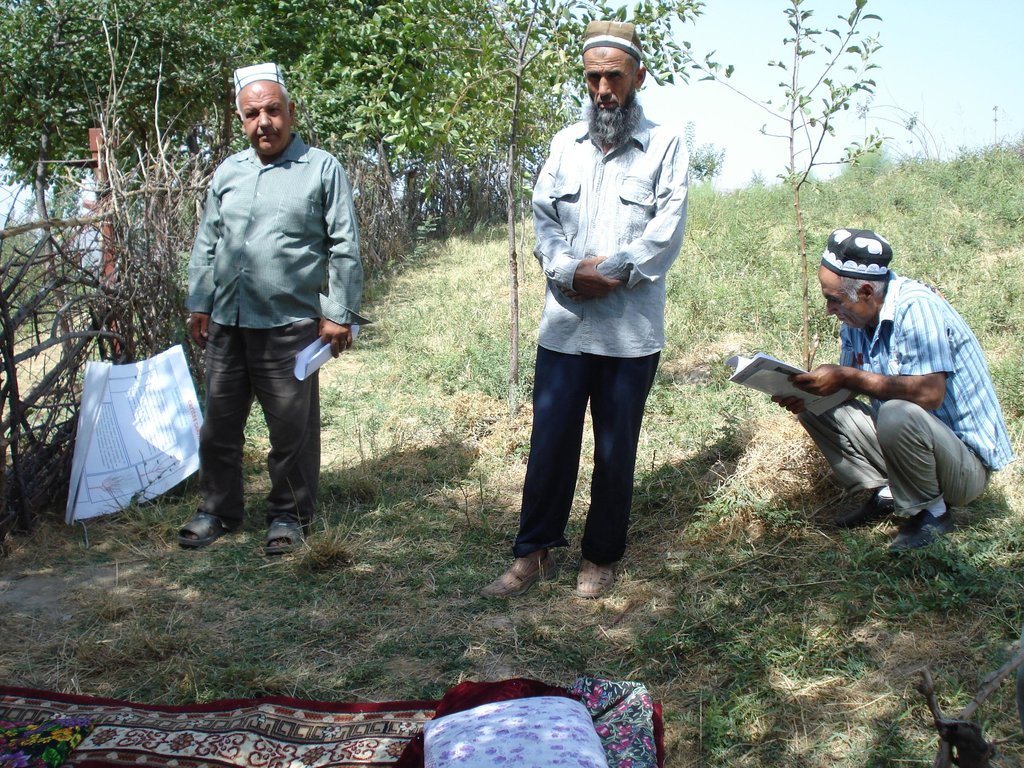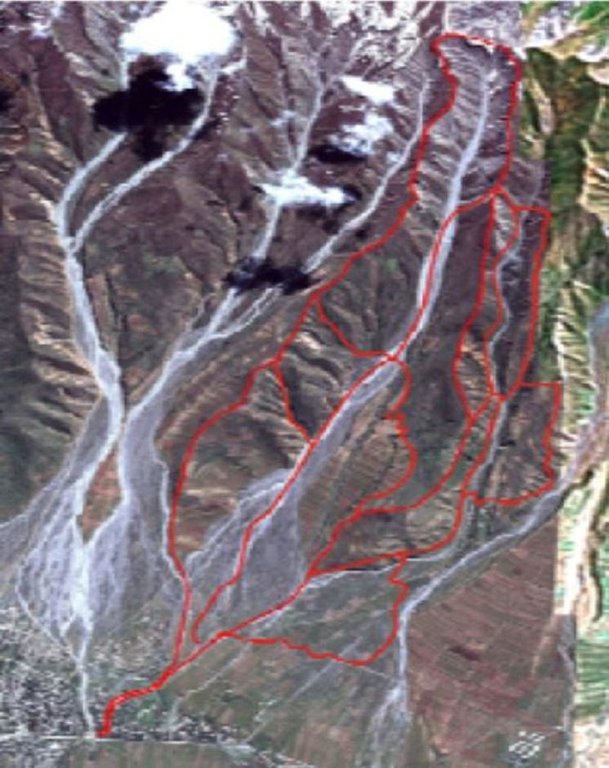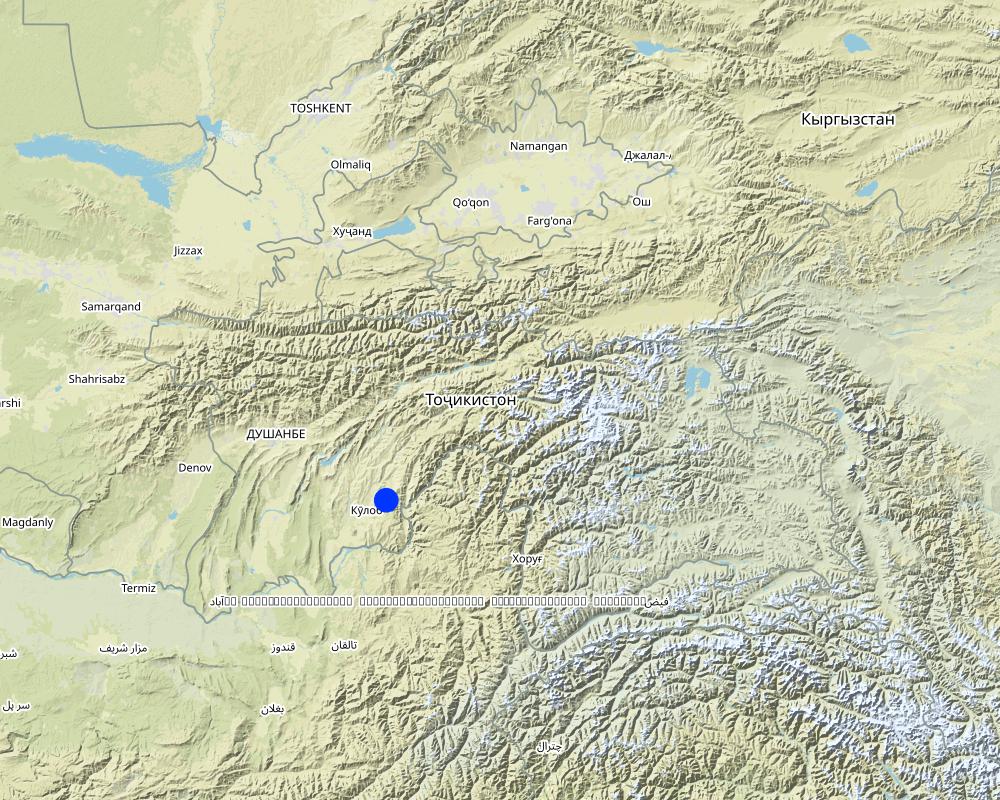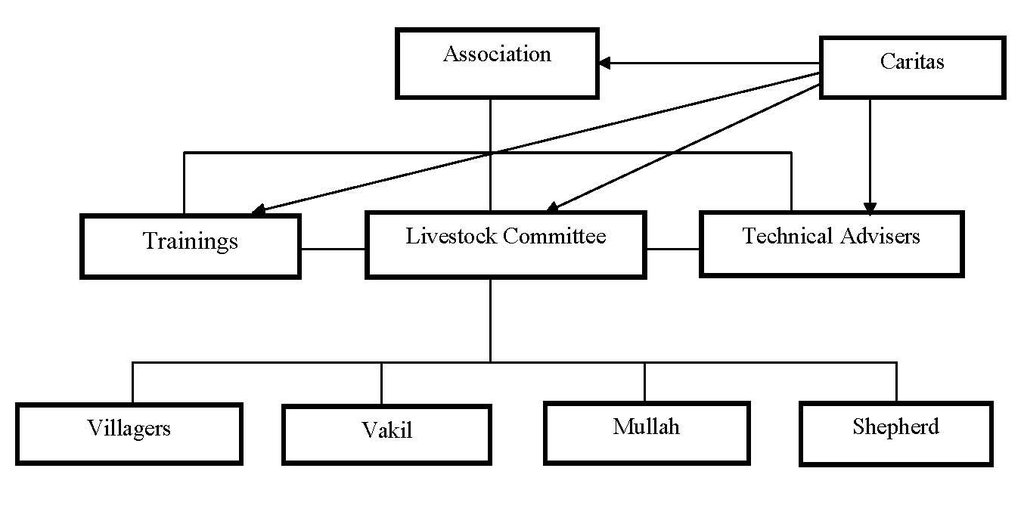Livestock Committee at Village Level [Tajiquistão]
- Criação:
- Atualização:
- Compilador/a: Sa'dy Odinashoev
- Editor: –
- Revisores: Deborah Niggli, David Streiff, Alexandra Gavilano, Joana Eichenberger
Кумитаи чорврдори дар сатхи деха
approaches_2435 - Tajiquistão
Veja as seções
Expandir tudo Recolher tudo1. Informação geral
1.2 Detalhes do contato das pessoas capacitadas e instituições envolvidas na avaliação e documentação da abordagem
Nome do projeto que facilitou a documentação/avaliação da Abordagem (se relevante)
Knowledge Management for Integrated Watershed Management and Disaster Risk Reduction (SDC / IWSM)Nome do projeto que facilitou a documentação/avaliação da Abordagem (se relevante)
Pilot Program for Climate Resilience, Tajikistan (WB / PPCR)1.3 Condições em relação ao uso da informação documentada através de WOCAT
Quando os dados foram compilados (no campo)?
16/08/2010
O compilador e a(s) pessoa(s) capacitada(s) aceitam as condições relativas ao uso de dados documentados através do WOCAT:
Sim
1.4 Referência ao(s) questionário(s) sobre tecnologias da GST
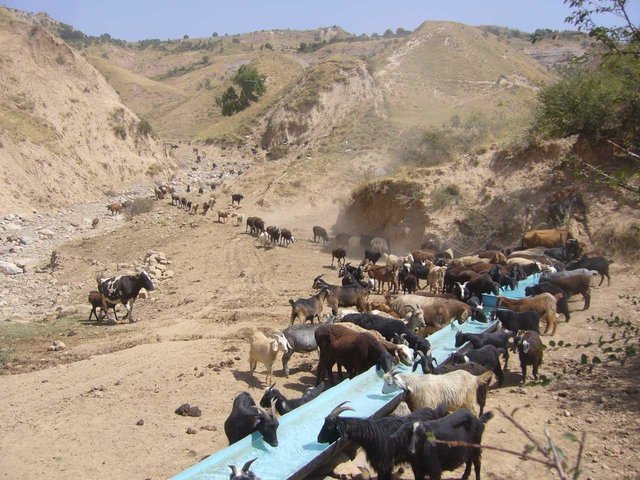
Rotational grazing supported by additional water points [Tajiquistão]
After the end of the Soviet era, an increased number of livestock with less grazing land available, has led to the deterioration of the pastures, including overgrazing, reduction of plant diversity, poor livestock health and soil erosion. To tackle the problem, Caritas Switzerland together with livestock committees at village level …
- Compilador/a: Sa'dy Odinashoev
2. Descrição da abordagem de GST
2.1 Descrição curta da abordagem
Livestock committees were established with the goal to improve livestock health as well as natural resource management in the watersheds where the village pastures were situated. Livestock committees in the Muminabad district are organised at village level and coordinate their activities through the registered livestock association at district level.
2.2 Descrição detalhada da abordagem
Descrição detalhada da abordagem:
Aims / objectives: This approach applied by Caritas Switzerland, aimed to improve natural resource management in the watersheds through an organised effort of livestock owners. It encourages preventive measures against soil erosion by providing incentives for beneficiaries at community level. The process is managed by the livestock committees, who represent the animal owners at village level. The committees are responsible for organising livestock owners and managing the village pastures by applying rotational grazing principles, establishment of water points and rest places, ensuring safe paths for animals and easy access to pasture lands.
Stages of implementation: The project encompasses the following steps: 1) Competitive call for project proposals to improve livestock and pasture management through villager's efforts, 2) Expression of interest from community members to participate in the competition, 3) Development of project proposals from villagers with assistance of technical staff from the implementing agency (Caritas), 4) Selection and notification of winners, confirmation of village funding commitments, 5) A village general meeting for the inception of project and laying the foundation for the livestock committee, 6) Formalisation of partnership agreement with donor (signed agreements for project implementation), 7) Project implementation transfer into livestock committee’s responsibility, 8) Technical assistance through training and workshops, monitored by the implementing agency (Caritas), 9) Strengthening of the livestock committee as a community based organisation, 10) follow up and continued activity of livestock committee through other projects and self organised activities among livestock owners.
Role of stakeholders: Various locals and village members are essential is assisting with the success of the project; The religious head (mullah) acts as a promoter of idea and mobilises the community through developing villager's interest; the village informal leader (vakil), helps to coordinate the activities; local organisations assist in informing and bringing people together for the meetings. The livestock committee consists of five members, including the appointed head shepherd. This has proven to be an effective size group. The main tasks of this committee include; mapping the pasture lands, organising rotational schemes, informing and training livestock owners of methods to improving pasture grazing, keeping villagers informed, establishing and collecting membership fees, keeping the accounts for the organisation, and application of funds (own or donor’s), develop new ideas and project proposals for further land improvement projects.
Other important information: The villagers are responsible for the labour contribution during the construction of water points or paths/roads. They pay membership fees, which cover the shepherd’s salary and the committee’s activities. They are kept informed of pasture grazing schemes, and control the performance of the committee.
2.3 Fotos da abordagem
2.5 País/região/locais onde a abordagem foi aplicada
País:
Tajiquistão
Região/Estado/Província:
Khatlon
Especificação adicional de localização:
Muminabad
Map
×2.6 Datas de início e término da abordagem
Indique o ano de início:
2004
Ano de término (caso a abordagem não seja mais aplicada):
2010
2.7 Tipo de abordagem
- Baseado em projeto/programa
2.8 Principais metas/objetivos da abordagem
The Approach focused mainly on SLM with other activities (Improve the health of livestock to water, safe roads to pasture and rest places)
To implement a responsible body to manage the common pasture land in the village, and improve conditions for livestock husbandry.
The SLM Approach addressed the following problems: Implementation of pasture projects and their sustainability. Little awareness and capacity in the field of sustainable pasture management among villagers, which hampers implementation of pasture projects.
2.9 Condição que propiciam ou inibem a implementação de tecnologia/tecnologias aplicada(s) segundo a abordagem
Normas e valores sociais/culturais/religiosos
- Inibitivo
hierarchical society, individual villagers wait for the religious or governmental leader to make decisions
Treatment through the SLM Approach: Livestock committee to coordinate with the leaders of the society
Disponibilidade/acesso a recursos e serviços financeiros
- Inibitivo
no funds available to pay a herder
Treatment through the SLM Approach: monthly contributions from the villagers
Quadro institucional
- Inibitivo
no formal organisation for management of the common pasture land at the village level
Treatment through the SLM Approach: village livestock committees
Quadro jurídico (posse de terra, direitos de uso da terra e da água)
- Propício
The existing land ownership, land use rights / water rights greatly helped the approach implementation: common management of common land by the livestock committee
- Inibitivo
unclear situation with regard to water use rights
Treatment through the SLM Approach: village negotiations are facilitated by Caritas Switzerland and the livestock committee
Conhecimento sobre GST, acesso a suporte técnico
- Inibitivo
limited access to technical knowledge regarding the setup of a water distribution system
Treatment through the SLM Approach: technical advice provided by specialists from Caritas Switzerland
Carga de trabalho, disponibilidade de força de trabalho
- Inibitivo
pasture improvement projects are too large for single people or families
Treatment through the SLM Approach: joint effort of the whole village
3. Participação e papel das partes interessadas envolvidas
3.1 Partes interessadas envolvidas na abordagem e seus papéis
- Usuários de terra/comunidades locais
all community members are involved
everybody can participate, disadvantaged groups have equal access
- Especialistas em GST/ consultor agrícola
international specialists
technical advisors are all male
- Organização não governamental
3.2 Envolvimento do usuários de terra/comunidades locais nas diferentes fases da abordagem
| Envolvimento do usuários de terra/comunidades locais | Especifique quem estava envolvido e descreva as atividades | |
|---|---|---|
| Iniciação/motivação | Participativo | Projects are elaborated by villagers with support of an international NGO |
| Planejamento | Participativo | village meetings, district meetings and proposal presentations |
| Implementação | Apoio externo | Cost sharing is from 80:20 up to 50:50. The village contributes the work force, stones and seedlings. Pipes and knowledge are provided externally. |
| Monitoramento/avaliação | Participativo | members of the livestock committee and international NGOs |
| Research | Nenhum |
3.3 Fluxograma (se disponível)
Descrição:
This organisational chart shows how the approach works at village level.
Autor:
Sady Odinashoev (Muminabad, Tajikistan)
3.4 Decisão sobre a seleção de tecnologia/tecnologias de GST
Especifique quem decidiu sobre a seleção de tecnologia/tecnologias a serem implementadas:
- Principalmente especialistas em GST, após consulta com usuários da terra
Explique:
Decisions on the method of implementing the SLM Technology were made by mainly by SLM specialists with consultation of land users
4. Suporte técnico, reforço das capacidades e gestão do conhecimento
4.1 Reforço das capacidades/formação
Foi oferecida formação aos usuários da terra/outras partes interessadas?
Sim
Especifique quem foi capacitado:
- Usuários de terra
Tipo de formação:
- Agricultor para agricultor
- Áreas de demonstração
- Reuniões públicas
Assuntos abordados:
Training in pasture management, rotational grazing, natural resource management and soil erosion.
4.2 Serviço de consultoria
Os usuários de terra têm acesso a um serviço de consultoria?
Sim
Especifique se foi oferecido serviço de consultoria:
- nas áreas dos usuários da terra
Descreva/comentários:
Key elements: theoretical and practical workshop, monitoring visits
Advisory service is quite adequate to ensure the continuation of land conservation activities; Government and other advisory service are now quite adequate to ensure the continuation of land conservation activities. The government saw the examples of good pasture management and is interested to continue with such approaches in collaboration with the livestock association.
4.3 Fortalecimento da instituição (desenvolvimento organizacional)
As instituições foram fortalecidas ou estabelecidas através da abordagem?
- Sim, significativamente
Especifique a que nível (níveis) as instituições foram fortalecidas ou estabelecidas:
- Local
Especifique o tipo de apoio:
- Reforço das capacidades/formação
Dê mais detalhes:
There were trainings for this Approach
4.4 Monitoramento e avaliação
Monitoramento e avaliação são partes da abordagem?
Sim
Comentários:
technical aspects were regular monitored by project staff through observations; indicators: water distribution system
management of Approach aspects were ad hoc monitored by project staff through observations; indicators: participation in committee meetings
pasture rotation aspects were regular monitored by project staff through observations; indicators: daily observations by the shepherd from the livestock committee
There were no changes in the Approach as a result of monitoring and evaluation: None
There were few changes in the Technology as a result of monitoring and evaluation: small changes on the road construction
4.5 Pesquisa
A pesquisa foi parte da abordagem?
Não
5. Financiamento e apoio material externo
5.1 Orçamento anual para o componente de GST da abordagem
Caso o orçamento exato seja desconhecido, indique a faixa:
- 2.000-10.000
Comentários (p. ex. principais fontes de recursos/principais doadores):
Approach costs were met by the following donors: International (seminars, workshops, meetings): 80.0%; local community / land user(s) (worktime, providing meeting place): 20.0%
5.2 Apoio financeiro/material concedido aos usuários da terra
Os usuários da terra receberam apoio financeiro/material para a implementação de tecnologia/tecnologias?
Sim
Caso afirmativo, especifique tipo(s) de apoio, condições e fornecedor(es):
Labour input by land users was rewarded with pipes, maps and technical support
5.3 Subsídios para entradas específicas (incluindo mão-de-obra)
- Equipamento
| Especifique quais entradas foram subsidiadas | Em que medida | Especifique os subsídios |
|---|---|---|
| Ferramentas | shovel, spades provided by village | |
- Agrícola
| Especifique quais entradas foram subsidiadas | Em que medida | Especifique os subsídios |
|---|---|---|
| seedlings | from household gardens | |
- Construção
| Especifique quais entradas foram subsidiadas | Em que medida | Especifique os subsídios |
|---|---|---|
| Pedra | collected from field | |
- Infraestrutura
| Especifique quais entradas foram subsidiadas | Em que medida | Especifique os subsídios |
|---|---|---|
| Estradas | Totalmente financiado | |
| pipes | Totalmente financiado | |
Se a mão-de-obra pelos usuários da terra foi uma entrada substancial, isso foi:
- Recompensado com outras formas de apoio material
5.4 Crédito
Foi concedido crédito segundo a abordagem para atividades de GST?
Não
5.5 Outros incentivos ou instrumentos
Foram utilizados outros incentivos ou instrumentos para promover a implementação das tecnologias de GST?
Sim
Caso afirmativo, especifique:
There were trainings for this Approach for local institutions
6. Análise de impactos e declarações finais
6.1 Impactos da abordagem
A abordagem auxiliou os usuários da terra a implementar e manter as tecnologias de GST?
- Não
- Sim, pouco
- Sim, moderadamente
- Sim, significativamente
The soil cover improved, the milk production increased and the cows became fatter and healthier.
A abordagem concedeu autonomia aos grupos social e economicamente desfavorecidos?
- Não
- Sim, pouco
- Sim, moderadamente
- Sim, significativamente
Everybody is benefitting in the same way.
A abordagem melhorou as questões de posse de terra/diretos do usuário que inibiam a implementação das tecnologias de GST?
- Não
- Sim, pouco
- Sim, moderadamente
- Sim, significativamente
livestock committee negotiated access to water
Did other land users / projects adopt the Approach?
- Não
- Sim, pouco
- Sim, moderadamente
- Sim, significativamente
But other organisations and the government have shown interest in these ideas.
Did the Approach lead to improved livelihoods / human well-being?
- Não
- Sim, pouco
- Sim, moderadamente
- Sim, significativamente
Improvement in pastures, and milk production. Livestock has high importance as it is a large financial investment.
Did the Approach help to alleviate poverty?
- Não
- Sim, pouco
- Sim, moderadamente
- Sim, significativamente
With this Approach the cows become heavier and produce more milk. These animals then achieve higher prices on the market.
6.2 Principal motivação dos usuários da terra para implementar a GST
- Produção aumentada
milk, meat
- Lucro (lucrabilidade) aumentado, melhora da relação custo-benefício
better food, less distance to walk for the animals
- Carga de trabalho reduzida
6.3 Atividades de sustentabilidade de abordagem
Os usuários da terra podem manter o que foi implementado através da abordagem (sem apoio externo)?
- Sim
Caso afirmativo, descreva como:
The committee and collaboration among different stakeholders are well organised and the committee is now working independently. Financial contributions per villager are quite low and villagers are willing to increase them in the future if required.
6.4 Pontos fortes/vantagens da abordagem
| Pontos fortes/vantagens/oportunidades na visão do usuário da terra |
|---|
| financial contributions of each village household creates ownership (How to sustain/ enhance this strength: Financial contributions per villager are low and can be afforded also by poor households. This assures ongoing contributions.) |
| Pontos fortes/vantagens/oportunidades na visão do compilador ou de outra pessoa capacitada |
|---|
| workshops in the villages (How to sustain/ enhance this strength: The livestock committees are integrated in an association and this will assure continued access to information.) |
6.5 Pontos fracos, desvantagens da tecnologia e formas de superá-los
| Pontos fracos/vantagens/riscos na visão do compilador ou de outra pessoa capacitada | Como eles podem ser superados? |
|---|---|
| Less participation of the women in the workshops | To explain to the men that women should also attend. |
7. Referências e links
7.1 Métodos/fontes de informação
- visitas de campo, pesquisas de campo
- entrevistas com usuários de terras
Links e módulos
Expandir tudo Recolher tudoLinks

Rotational grazing supported by additional water points [Tajiquistão]
After the end of the Soviet era, an increased number of livestock with less grazing land available, has led to the deterioration of the pastures, including overgrazing, reduction of plant diversity, poor livestock health and soil erosion. To tackle the problem, Caritas Switzerland together with livestock committees at village level …
- Compilador/a: Sa'dy Odinashoev
Módulos
Não há módulos


